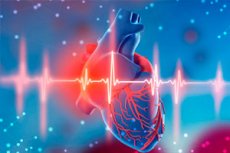New publications
PSAT1 Gene Therapy: A Breakthrough in Myocardial Regeneration after Acute Infarction
Last reviewed: 09.08.2025

All iLive content is medically reviewed or fact checked to ensure as much factual accuracy as possible.
We have strict sourcing guidelines and only link to reputable media sites, academic research institutions and, whenever possible, medically peer reviewed studies. Note that the numbers in parentheses ([1], [2], etc.) are clickable links to these studies.
If you feel that any of our content is inaccurate, out-of-date, or otherwise questionable, please select it and press Ctrl + Enter.

Scientists from RIKEN (Japan), Kyoto University and Stanford University are revealing a powerful cardiac regeneration protocol in Theranostics: a single delivery of PSAT1-modified RNA (modRNA) or an AAV vector with the Phosphoserine Aminotransferase 1 (PSAT1) gene to the infarcted area of the heart activates endogenous serine synthesis, which leads to cardiomyocyte proliferation, neovascularization and significant improvement in left ventricular function.
Why PSAT1?
After infarction, adult cardiomyocytes almost completely lose their ability to divide, and the scar area fills with connective tissue, which leads to a decrease in pump function. PSAT1 catalyzes the first rate-limiting step of the serine synthesis pathway (SSP) from the glycolytic intermediate 3-phosphoglycerate. Serine is a key substrate for one-carbon metabolism, nucleotide synthesis, and glutathione-mediated protection against oxidative stress.
Preclinical mouse model
Induction of infarction: occlusion of the left anterior descending coronary artery (LAD) in C57BL/6 mice.
Delivery of therapy: single administration to the peri-infarction zone
PSAT1-modRNA (rapidly decaying, no genomic integration)
AAV9-PSAT1 (long-term expression)
Expression verification: Peak PSAT1 levels were observed at 24–48 h (modRNA) or 7–14 d (AAV9) by western blot and immunofluorescence.
Outcomes after 4-6 weeks:
Cardiomyocyte proliferation: Ki67⁺/cTnT⁺ cells increased 2.5-fold in the border zone of the scar (p<0.001).
LV function: ejection fraction (EF) increased from 35% to 50–52% (control – 38%).
Scar size: connective tissue area decreased by 40% (Masson's trichrome, p<0.001).
New vascularization: CD31⁺ capillary density increased by 60% in the treatment area.
Confirmation in a pig model
- Mini-pig model: acute LAD occlusion in Yucatan mini-pigs.
- AAV9-PSAT1: single-dose delivery to the myocardium during revascularization (similar to stenting).
- Results after 8 weeks:
- EF increased by 12% (from 30% to 42%).
- The scar has been reduced by 25%.
- Safety: No arrhythmias, off-target inflammation, or immune response to the vector were detected.
Mechanical parts
Metabolomics showed:
Increase in serine and glutathione in cardiomyocytes by 45%.
Reduction of ROS by 35%, which protects cells from apoptosis.
Border zone scRNA-seq:
Increased expression of Ccnd1, Mki67, Aurkb (proliferative markers).
Activation of Vegfa, Angpt2 (angiogenesis).
CRISPR knockout of PSAT1 in cardiomyocytes abolished all therapeutic effects, confirming specificity.
Authors' statements
“PSAT1 opens the door for cardiomyocytes to divide, restoring lost cardiac function after a heart attack,” says Dr. Tsuji Masahiro.
“The pig model demonstrates clinical applicability: AAV9-PSAT1 can be administered simultaneously with revascularization without adding significant complexity to the procedure,” adds Prof. Li Chen of Stanford.
Prospects for clinical translation
- Phase I: Evaluation of safety and dosage of PSAT1-modRNA in patients with acute STEMI in the first 24–72 h after revascularization.
- Phase II/III: Comparison of AAV9-PSAT1 with control for improvement in EF, scar reduction and readmissions.
- Response biomarkers: plasma serine/glutathione levels, CM-MRI of infarct volume, apoptosis markers in biopsies.
Conclusion
This study demonstrates a novel gene-metabolism approach to cardiac regeneration: transient activation of serine synthesis via PSAT1 allows adult cardiomyocytes to reenter the cell cycle, expand the capillary network, and restore function after infarction. Gene and modRNA therapies targeting PSAT1 promise to change the paradigm of acute myocardial infarction treatment by reducing scarring and decreasing the risk of heart failure.
